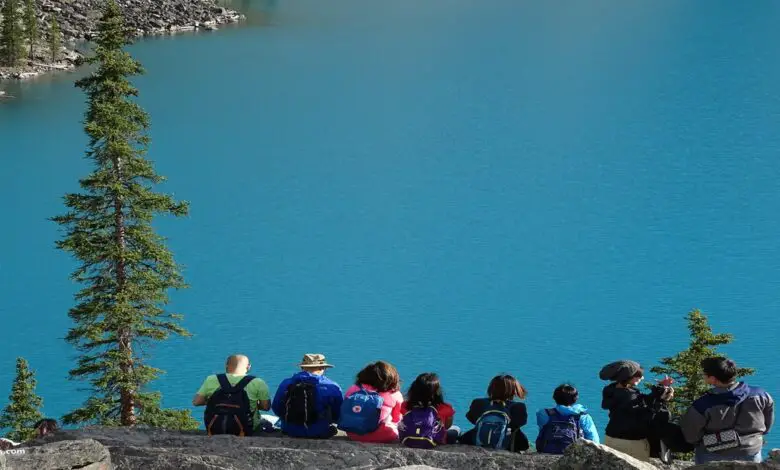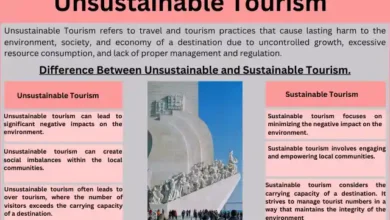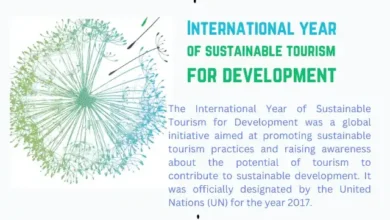
Sustainable Tourism | What is Tourism | Features of Sustainable Tourism
Sustainable Tourism
The world is a book; those who do not travel read only one chapter”. St Augustine explained the truth of traveling and tourism in a single phrase.
Traveling for leisure or work is one of the most common activities. Over time, however, the number of people traveling around the world increased. This resulted in the emergence of new challenges and problems. For instance, pollution, exploitation of natural resources, and loss of cultural heritage.
To counter the challenges, experts came up with the idea of Sustainable Tourism.
This article describes the idea of Sustainable Tourism, Why is it important? using global examples.
What is Tourism?
Tourism is a leisure activity that is a major part of the world economy. Tourism is the concept of traveling around the world to discover and see new places.
In ancient times, travel was bound with work and business. The places one visited did not hold any value compared to the worldly profit the person made. With the modern era, the notion of traveling changed, and the concept of tourism emerged.
The person going on a tour is known as a tourist, and the whole process is viewed as part of a larger and global phenomenon of tourism. The notion, however, changed with the advancement of understanding nature, and the new term Sustainable Tourism has become a hot topic.
What is Sustainable Tourism?
Sustainable means something long-lasting, effective, and having minimum side effects. Sustainability with humans means the peaceful co-existence of man with nature.
Sustainable Tourism is defined as the ideal form of tourism that does not pose any threats to the ecosystem of the world. It is the type of tourism that does not harm nature, the tourist site, the local culture, or the global balance of the earth. It creates better travel opportunities for tourists to travel around the world with minimum negative impacts.
Aspects or Features of Sustainable Tourism
Sustainable tourism is not something that can be easily achieved as it is concerned with the social, economic, and environmental aspects. It is a wholesome process that aims at bringing the best tourist experiences with minimum natural conflicts. Some of the main features of Sustainable Tourism are
Creating better travel opportunities
Sustainable tourism focuses on making tourism inclusive and available for everyone. In other words, everyone should be given equal opportunities to travel.
Maintaining the social, environmental, and economic balance.
Tourism should not be a threat to the social and cultural heritage of the tourist site. Instead, it should be a way of promoting cultural, social, and economic growth.
Creating better economic opportunities for the locals of tourist destinations.
Sustainable Tourism provides the ideal economic scenario for the local people as it focuses on creating better job opportunities.
Conserving cultural heritage, wildlife, and natural beauty of the place
Ecotourism and Sustainable tourism are closely linked, with the aspect of protecting the natural beauty of the tourist destination.
Bridging the Gap between the tourists and the local people for better interactions and opportunities
Sustainable Tourism focuses on creating better interaction opportunities between the tourist and the local population resulting in a better tourist experience.
Why Sustainable Tourism?
The main point to ponder is why we need sustainable tourism. It might seem bothersome and a great hassle to focus on creating better opportunities and tourist experiences when we can continue with traditional, hassle-free tourism.
Let’s look at the reasons one by one, that led to the development of sustainable tourism.
Mass Tourism
Close your eyes for a moment and think of a mass of people packed in a small city with barely enough space to move. Suffocating, isn’t it? For people like me who are claustrophobic, the experience can be terrifying.
The large number of people opting to travel to famous cities, amusement parks, and other tourist sites at the same time put the sites at huge damage risk. Mass tourism did not only create management problems but also proved to be a threat to cultural sites and natural landscapes.
Global Warming and Climate Change
Recent research revealed that tourism contributes up to 8% of global Greenhouse gas emissions, which is A Lot. Considering the drastically changing climate patterns, sudden heat waves, and natural disasters this 8% is not a small proportion but a large contribution to the worsening conditions.
Moreover, the ever-increasing tourism rate will only increase the pollution rate.
Destruction of Cultural Heritage
One of the most common problems with tourism is the threat mass tourism poses to tourist sites. According to UNESCO, more than 12% of the World’s Cultural heritage sites are in danger because of Tourism.
Adding to this is the effect on the social life of the local inhabitants by the tourist. Tourists not only observe the culture of the place they are visiting but also represent their own culture which can result in Cultural changes and heritage loss.
Exploitation of resources
With the ever-growing number of people in a small area, natural and human resources face the threat of exploitation. Mass Tourism causes huge pressure on natural resources.
Examples of Sustainable Tourism
Forest Tourism
The Halliburton Sustainable Forest in central Ontario, Canada, is a sustainably managed and privately owned 100,000 forest that supports both tourism and the logging Industry. With careful planning, the forest has turned out to be a huge success and a role model for several other sustainable tourism projects. In just over four decades, the forest has been transformed from run-down forestry-holding to a flourishing, multi-use operation with benefits to owners, employees, and the public at large as well as the environment.
Tourist Cities
Machu Pichu of Peru was recognized as the first sustainable city in Latin America in 2019 because of its ideal waste management systems. Cities like these can make a huge impact in maintaining the balance of the ecosystem and reducing the environmental hazards of tourism.
Conclusion
Sustainable Tourism is part of the Sustainable Development Goals, SDG, aiming at a more balanced interaction of humans with nature. It is a collective effort to create better travel opportunities, less pollution, and conserve the natural beauty and cultural heritage of the tourist sites.




